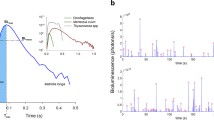Abstract
Research since 2009 has shown that despite almost total darkness during the Arctic polar night, there is much more biological activity than previously assumed, both at the sea surface, water column and sea floor. Here, we describe in situ monitoring of the bioluminescent fraction of the zooplankton community (dinoflagellates, copepods, krill and ctenophores) as a function of time and space. In order to examine the relative contribution of each selected taxon and any diurnal patterns in the relative signals, a time series platform capable of detecting in situ bioluminescent flashes was established in Kongsfjord, Svalbard, during the polar night in January 2013. Combined with laboratory-controlled measurements of animals collected next to the time series platform, we present both taxon-specific and community characteristics of the bioluminescence signal from a location at 79°N and from the middle of the polar night. Based on this 51-h time series, we conclude that the bioluminescent fraction of the zooplankton does not maintain a diurnal signal. Rather, the frequency of bioluminescence flashes from the entire bioluminescent community remained steady throughout the sampling period. Furthermore, we conclude that bioluminescence flash kinetic characteristics have a strong potential for in situ taxa recognition of zooplankton.





Similar content being viewed by others
References
Båtnes AS, Miljeteig C, Berge J, Greenacre M, Johnsen G (2013) Quantifying the light sensitivity of Calanus spp. during the polar night: potential for orchestrated migrations conducted by ambient light from the sun, moon, or aurora borealis? Polar Biol DOI 10.1007/s00300-013-1415-4, Electronic supplementary material doi:10.1007/s00300-013-1415-4
Berge J, Cottier F, Last K, Varpe Ø, Leu E, Søreide J, Eiane K, Falk-Petersen S, Willis K, Nygård H, Voegedes D, Griffiths C, Johnsen G, Lorenzen D, Brierley AS (2009) A diel vertical migration of Arctic zooplankton during the polar night. Biol Lett. doi:10.1098/rsbl.2008.0484
Berge J, Båtnes AS, Johnsen G, Blackwell SM, Moline MA (2012) Bioluminescence in the high Arctic during the polar night. Mar Biol 159:231–237. doi:10.1007/s00227-011-1798-0
Bluhm BA, Gebruk AV, Gradinger R, Hopcroft RR (2011) Arctic marine biodiversity: an update of species richness and examples of biodiversity change. Oceanography 24:232–248
Haddock SHD, Moline MA, Case JF (2010) Bioluminescence in the sea. Annu Rev Mar Sci 2:443–493
Herren CM, Haddock SHD, Johnson C, Moline MA, Case JF (2005) A multi-platform bathyphotometer for fine-scale, coastal bioluminescence research. Limnol Oceanogr Methods 3:247–262
Hirche HJ, Kosobokova KN (2011) Winter studies on zooplankton in Arctic seas: the Storfjord (Svalbard) and adjacent ice-covered Barents Sea. Mar Biol 158:2359–2376
Lapota D, Rosenberger DE, Lieberman SH (1992a) Planktonic bioluminescence in the pack ice and the marginal ice zone of the Beaufort Sea. Mar Biol 112:665–675
Lapota D, Young D, Bernstein S, Geiger M, Huddell HDL, Case JF (1992b) Diel bioluminescence in heterotrophic and photosynthetic marine dinoflagellates in an Arctic fjord. J Mar Biol Assoc UK 72:733–744
Majaneva S, Berge J, Renaud PE, Vader A, Stübner E, Rao AM et al (2013) Aggregations of predators and prey affect predation impact of the Arctic ctenophore Mertensia ovum. Mar Ecol Progr Ser 476:87–100. doi:10.3354/meps10143
Moline MA, Oliver MJ, Orrico C, Zaneveld R (2013) Bioluminescence in the sea. In: Watson J, Zielinski O (eds) Subsea optics and imaging, Chapter 7. Woodhead Publishing Ltd., Cambridge, pp 134–170 608 pp
Moline MA, Berge J, Johnsen G, Båtnes A, Blackwell S (in press) Bioluminescence flash kinetics characterize pelagic community structure. J Plankton Res
Polyak L, Alley RB, Andrews JT, Brigham-Grette J, Cronin TM et al (2010) History of sea ice in the Arctic. Quat Sci Rev 29:1757–1778. doi:10.1016/j.quascirev.2010.02.010
Sakshaug E, Johnsen G, Kovacs K (2009) Ecosystem Barents Sea. Tapir Academic Press, Trondheim 587 pp
Wang M, Overland J (2009) A sea ice free summer Arctic within 30 years. Geophys Res Lett 36:L07502. doi:10.1029/2009GL037820
Weslawski JM, Kwasniewski S, Wiktor J (1991) Winter in a Svalbard fjord ecosystem. Arctic 44:115–123
Acknowledgments
The work is part of the two NFR projects Circa (Project Number 214271/F20) and Marine Night (Project Number 226417/E10). Furthermore, the work was supported by the CoE AMOS at NTNU (NFR 223254). Thanks are given two three anonymous reviewers for constructive comments.
Author information
Authors and Affiliations
Corresponding author
Additional information
This article belongs to the special Polar Night issue, coordinated by Ole Jørgen Lønne.
Rights and permissions
About this article
Cite this article
Johnsen, G., Candeloro, M., Berge, J. et al. Glowing in the dark: discriminating patterns of bioluminescence from different taxa during the Arctic polar night. Polar Biol 37, 707–713 (2014). https://doi.org/10.1007/s00300-014-1471-4
Received:
Revised:
Accepted:
Published:
Issue Date:
DOI: https://doi.org/10.1007/s00300-014-1471-4




